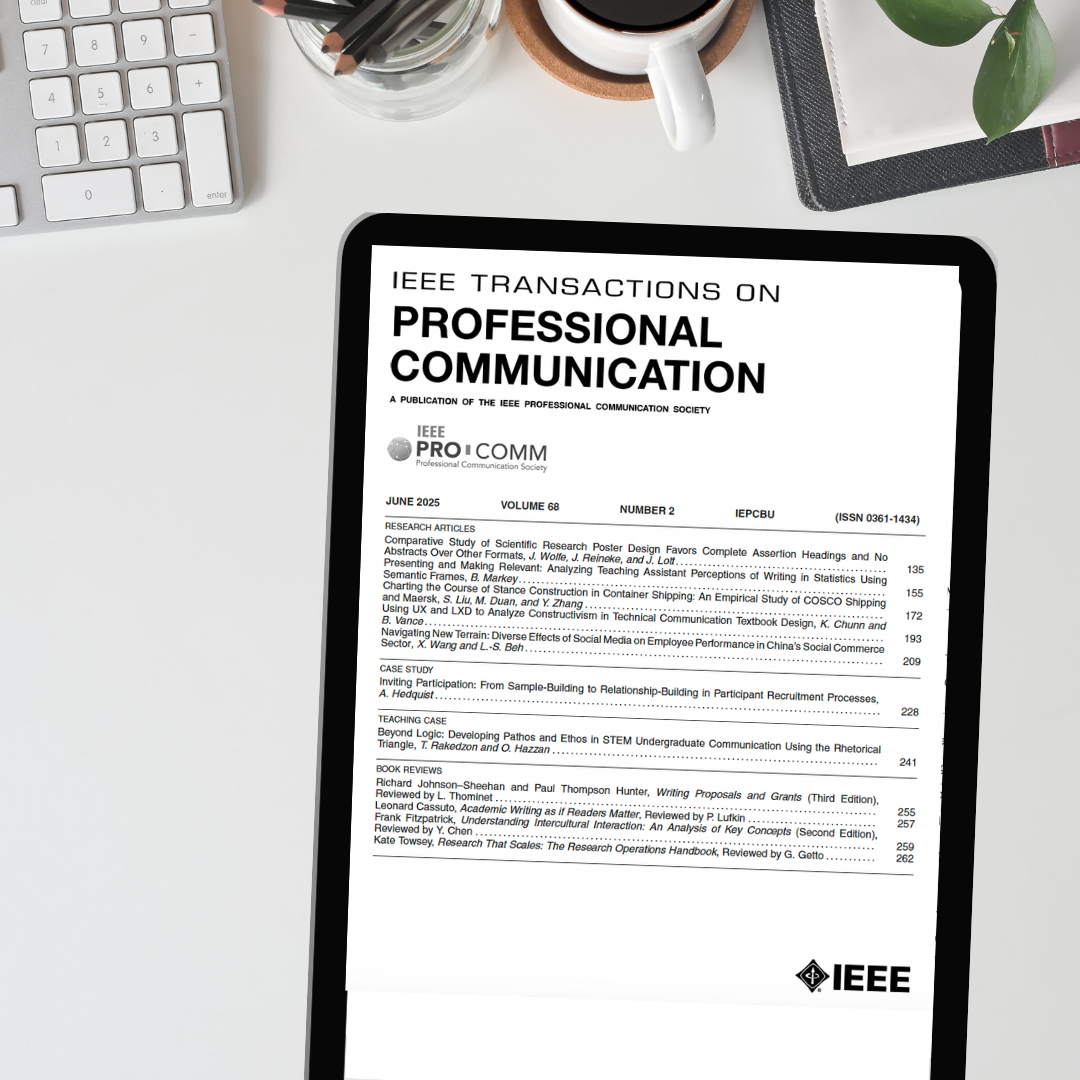IEEE Transactions on Prof Comm: June 2025
Published on July 7, 2025
IEEE Transactions on Professional Communication
JUNE 2025 VOLUME 68 NUMBER 2 IEPCBU (ISSN 0361-1434)

RESEARCH ARTICLES
Comparative Study of Scientific Research Poster Design Favors Complete Assertion Headings and No Abstracts Over Other Formats, J. Wolfe, J. Reineke, and J. Lott
Complete Assertion Headings, compared to topical headings, improved student recall, and students preferred the complete assertion format. Engineering educators preferred nontraditional poster formats (both the Complete Assertion Heading and the #betterposter format) to the traditional IMRD + Abstract format. Mechanical engineering faculty preferred the Complete Assertion Heading to other formats. We recommend that practitioners consider using Complete Assertion Headings on their posters, and we provide examples of exemplary student posters.
This study interviewed three TAs from an introductory statistics course about their perceptions of writing in statistics. Frame semantics was used to analyze TA responses. Less experienced TAs perceived writing as a means of presentation, which entailed a weak sense of rhetoric in technical communication and a muddied understanding of writing assessment. The more advanced TA perceived writing as a means of contextualizing statistical evidence for audiences. Due to their maturing perceptions of writing in their disciplines, TAs might not possess the ability to deliver quality formative feedback. One means of support for these TAs may be opportunities to discuss assessment decisions with one another, thereby calibrating against available expectations and rubrics.
Charting the Course of Stance Construction in Container Shipping: An Empirical Study of COSCO Shipping and Maersk, S. Liu, M. Duan, and Y. Zhang
This study employed corpus linguistics and discourse analysis of CSR reports (2016-2022) of COSCO Shipping and of Maersk. Maersk employs more stance markers of hedges, attitude markers, and general self-mentions, reflecting a more personal communication style, while COSCO Shipping favors boosters and formal self-references, indicating an authoritative approach. These features are informed by the contrast between European rationalism and Eastern empiricism in corporate communication. Our four-category classification of self-mentions (general, specific reference, group, and affiliated) addresses the complexities of shipping corporate discourse. Diachronic analysis shows stance marker usage fluctuations, particularly during global events like the COVID-19 pandemic.
Using UX and LXD to Analyze Constructivism in Technical Communication Textbook Design, K. Chunn and B. Vance
The study employed a heuristic review using a novel heuristic, the Constructivist Textbook Rubric, to evaluate a sample of eight technical communication textbooks. Following this, comparative usability testing was conducted with both professors and students to assess preferences and learning outcomes. The findings suggest that textbooks designed with constructivist principles can improve learning outcomes for both learners and faculty. By using the Constructivist Textbook Rubric, college instructors can make informed decisions when selecting textbooks, ultimately benefiting learners through enhanced information synthesis and retention.
Navigating New Terrain: Diverse Effects of Social Media on Employee Performance in China’s Social Commerce Sector, X. Wang and L.-S. Beh
We surveyed 520 Chinese social commerce professionals, using self-reported questionnaires to investigate how social media use affects employee performance. Social media positively impacts job performance, with benefits outweighing drawbacks. It enhances knowledge-sharing behaviors, which in turn improves employee performance. It also causes five technostress factors, but only techno-overload and techno-uncertainty significantly reduce employee performance. Additionally, guanxi moderates the relationship between social media use and knowledge-sharing behaviors and strengthens the indirect effect of social media use on work performance through knowledge-sharing. However, this moderated mediation effect is not significant at low levels of guanxi.
CASE STUDY
Inviting Participation: From Sample-Building to Relationship-Building in Participant Recruitment Processes, A. Hedquist
Universities rely on study advertisements to initiate recruitment on study discovery sites which can serve as the foundation for the participant-researcher relationship. After tracking and defining the rhetorical moves in study advertisements, the moves were characterized through invitational rhetoric to assess how they create conditions for value, safety, and freedom. The study found that the main rhetorical moves of the advertisements were establishing credentials, introducing the offer (offering the product or service, essential detailing of the offer, indicating value of the offer), including study identifiers, and soliciting responses. The moves enacting invitational rhetoric were attentive to building reciprocity, transparency, and agency.
TEACHING CASE
Beyond Logic: Developing Pathos and Ethos in STEM Undergraduate Communication Using the Rhetorical Triangle, T. Rakedzon and O. Hazzan
We suggest using Aristotle’s rhetorical triangle, a tool for analyzing communication in terms of logos (logic), pathos (values), and ethos (identity), in science, technology, engineering, and mathematics (STEM) undergraduate classes. We investigate how the triangle can enhance students’ communication skills by developing awareness of pathos and ethos, and shed light on values, considerations, and professional identity at different stages of their studies. Our results show that our intervention enhanced students’ ability to express shared values (pathos) with their audience and fostered the development of professional identity (ethos). Our findings also revealed notable differences in professional identity expression when comparing two different samples of future scientists and engineers in their freshmen and senior years.

